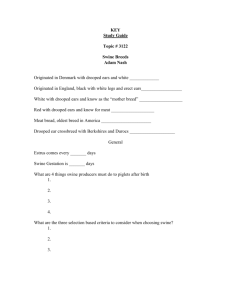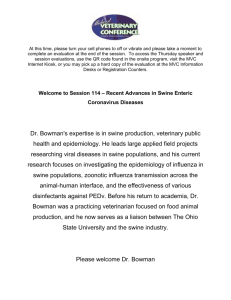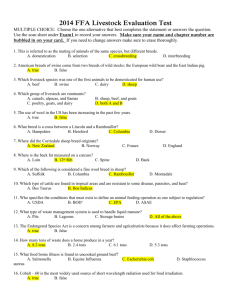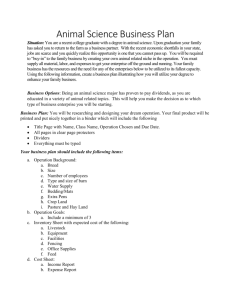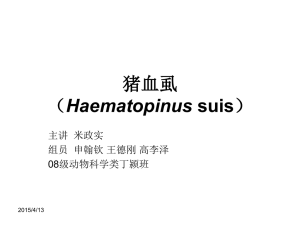12C Breeds of Swine LP - Educational Excellence
advertisement
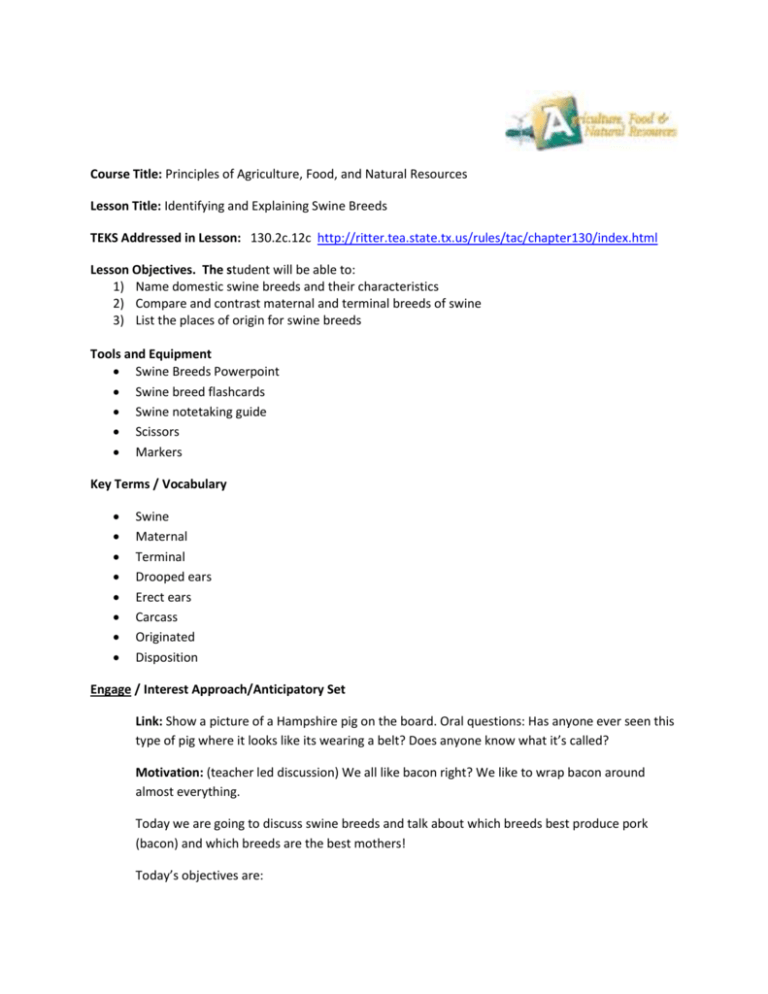
Course Title: Principles of Agriculture, Food, and Natural Resources Lesson Title: Identifying and Explaining Swine Breeds TEKS Addressed in Lesson: 130.2c.12c http://ritter.tea.state.tx.us/rules/tac/chapter130/index.html Lesson Objectives. The student will be able to: 1) Name domestic swine breeds and their characteristics 2) Compare and contrast maternal and terminal breeds of swine 3) List the places of origin for swine breeds Tools and Equipment Swine Breeds Powerpoint Swine breed flashcards Swine notetaking guide Scissors Markers Key Terms / Vocabulary Swine Maternal Terminal Drooped ears Erect ears Carcass Originated Disposition Engage / Interest Approach/Anticipatory Set Link: Show a picture of a Hampshire pig on the board. Oral questions: Has anyone ever seen this type of pig where it looks like its wearing a belt? Does anyone know what it’s called? Motivation: (teacher led discussion) We all like bacon right? We like to wrap bacon around almost everything. Today we are going to discuss swine breeds and talk about which breeds best produce pork (bacon) and which breeds are the best mothers! Today’s objectives are: Name domestic swine breeds and their characteristics Compare and contrast maternal and terminal breeds of swine List the places of origin for swine breeds Explore & Explain / Teaching Plan and Strategy / Presentation of New Material: 1. The teacher will walk through the swine breeds PowerPoint. Landrace • Originated in Denmark • Drooped ears • Known for their maternal instincts • White • Know for long bodies • Flatter-topped than other breeds Berkshire • Originated in England • Black with white legs, snout and switch • Once kept at Buckingham Palace • Known for producing high quality meat (desirable ratio of lean to fat) • Erect ears Chester White • Originated in Chester County, Pennsylvania • White with drooped ears • Maternal breed • Known to produce large litters Duroc • Originated in the United States (northeastern) • Solid red • Drooped ears • Slight dish to the face • Meat type swine • Aggressive Hampshire • Originated in southern Scotland and imported into the United States • Oldest American breed • Black with a white belt • White covering more than 2/3 of the body is not tolerated • Small, erect ears • Well-known meat breed • Produce high quality carcasses with little waste Poland China • Originated in the US (Ohio) • Noted for ability to easily gain weight • Quiet dispositions • Black with white snouts, legs and switch • Generally poor mothers • Drooped ears • Spot • Developed in Indiana • Black and white spots • Efficient feeders • Noted for rapid weight gain Yorkshire • Originated in England • White • Large, erect ears • Known as “The Mother Breed” • Produces large litters • Bacon-type hog 2. The students will take notes over swine breeds on the note-taking guide. Elaborate / Activity/Application/ Student Engagement /Laboratory 1. For today’s activity students will be making swine breed flashcards. Students will receive sheets of pig-clip art. Students will cut out the pigs in squares. On the front of the flashcard, students will color the pig according to the breed characteristics. The pigs don’t have any ears, so students will have to draw their ears, according to the breed. On the back, students will write pertinent facts about that particular breed. 2. After students finish making their flash cards, they will get with partner and quiz each other. They should continue this as time allows. Evaluation / Summary: At the end of class, students will independently complete the Swine Vocabulary and Breed Quiz. References/Additional Materials / Extended Learning Opportunities/ Enrichment www.glenrosearkansasffa.com/swine%20breeds.ppt www.aubreyisd.net/cms/lib/TX21000411/.../366/swine%20breeds.ppt College & Career Readiness Standard Science X. E.1a & 3a. ©Texas Education Agency, 2015


